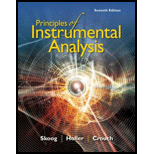
(a)
Interpretation: The six factors which are significant in the optimization of the electrothermal AAS method needs to be listed. The physical basis of each factor and their important needs to be explained.
Concept Introduction:
Generally, the optimization methods are basically used in order to maximize or minimize the parameters of study. In this way, cost in the production can be minimized and profit can be maximized. It involves the minimization of raw material and increase in productivity.
(b)
Interpretation: The priori method and the method described in given section needs to be compared. The use of priori method to improve the method define by IUPAC also, the disadvantage of using this method needs to be explained.
Concept Introduction: In instrumentation analysis, the detection limit or limit of detection (LOD) can be confused with analytical sensitivity. The LOD is the lowest quantity of substance which can be differentiated from the blank value (absence of the substance) with stated confidence level. This level is generally 99%.
(c)
Interpretation: This is to be explained how the mentioned data for the investigations described by carbon and Bihan is smoothed. The experimental variable which is optimized in the smoothing procedure needs to be determined. The way of defining the smoothing window and the effect of the smoothing procedure on the LOD determined by the workers needs to be explained. The effect on the determination of the integration window for the instrumental signal needs to be explained.
Concept introduction: The signal-to-noise enhancement devices are nowadays replaced by computer programs. These programs include various types of averaging, Fourier transformation, digital filtering, correlation techniques and smoothing. The procedures are applied on irregular waveforms for example, adsorption spectrum.
(d)
Interpretation: The outcome of the comparison of the determination of the signal magnitude by measuring the peak signals and integration needs to be explained. The results need to be explained on the basis of signal to noise enhancement procedures.
Concept Introduction:
In the analytical signal processing, the integration of the digitized signals is done. It is used mainly as a method of measuring areas under the peak type signals curves. In the chromatography technique, this peak area measurements are important to be performed.
(e)
Interpretation: The integration of the instrument signals needs to be explained. The alternative numerical procedure for the same needs to be explained. The effect of the procedural variables on the quality and effect of the signal integration on the working curves for Pb needs to be explained.
Concept Introduction: The boxcar averaging is done for smoothing the irregularities present in the signal and to enhance the signal-to-noise ratio in the waveform.
(f)
Interpretation: The term dosing volume needs to be explained. The effect of the same on the quality of the results in the explained procedure needs to be explained.
Concept Introduction: The electrothermal atomization is used successfully in the atomic spectrometry due to the potential of high sensitivity, the micro or solid samples and high accuracy precision.
Want to see the full answer?
Check out a sample textbook solution
Chapter 9 Solutions
Principles of Instrumental Analysis
- What is the final product when D-galactose reacts with hydroxylamine?arrow_forwardIndicate the formula of the product obtained by reacting methyl 5-chloro-5-oxopentanoate with 1 mole of 4-penten-1-ylmagnesium bromide.arrow_forwardIn the two chair conformations of glucose, the most stable is the one with all the OH groups in the equatorial position. Is this correct?arrow_forward
- please help me with my homeworkarrow_forwardhelparrow_forwardThe temperature on a sample of pure X held at 1.25 atm and -54. °C is increased until the sample boils. The temperature is then held constant and the pressure is decreased by 0.42 atm. On the phase diagram below draw a path that shows this set of changes. pressure (atm) 2 0 0 200 400 temperature (K) Xarrow_forward
- QUESTION: Answer Question 5: 'Calculating standard error of regression' STEP 1 by filling in all the empty green boxes *The values are all provided in the photo attached*arrow_forwardpressure (atm) 3 The pressure on a sample of pure X held at 47. °C and 0.88 atm is increased until the sample condenses. The pressure is then held constant and the temperature is decreased by 82. °C. On the phase diagram below draw a path that shows this set of changes. 0 0 200 temperature (K) 400 аarrow_forwarder your payment details | bar xb Home | bartleby x + aleksogi/x/isl.exe/1o u-lgNskr7j8P3jH-1Qs_pBanHhviTCeeBZbufuBYT0Hz7m7D3ZcW81NC1d8Kzb4srFik1OUFhKMUXzhGpw7k1 O States of Matter Sketching a described thermodynamic change on a phase diagram 0/5 The pressure on a sample of pure X held at 47. °C and 0.88 atm is increased until the sample condenses. The pressure is then held constant and the temperature is decreased by 82. °C. On the phase diagram below draw a path that shows this set of changes. pressure (atm) 1 3- 0- 0 200 Explanation Check temperature (K) 400 X Q Search L G 2025 McGraw Hill LLC. All Rights Reserved Terms of Use Privacy Cearrow_forward
 ChemistryChemistryISBN:9781305957404Author:Steven S. Zumdahl, Susan A. Zumdahl, Donald J. DeCostePublisher:Cengage Learning
ChemistryChemistryISBN:9781305957404Author:Steven S. Zumdahl, Susan A. Zumdahl, Donald J. DeCostePublisher:Cengage Learning ChemistryChemistryISBN:9781259911156Author:Raymond Chang Dr., Jason Overby ProfessorPublisher:McGraw-Hill Education
ChemistryChemistryISBN:9781259911156Author:Raymond Chang Dr., Jason Overby ProfessorPublisher:McGraw-Hill Education Principles of Instrumental AnalysisChemistryISBN:9781305577213Author:Douglas A. Skoog, F. James Holler, Stanley R. CrouchPublisher:Cengage Learning
Principles of Instrumental AnalysisChemistryISBN:9781305577213Author:Douglas A. Skoog, F. James Holler, Stanley R. CrouchPublisher:Cengage Learning Organic ChemistryChemistryISBN:9780078021558Author:Janice Gorzynski Smith Dr.Publisher:McGraw-Hill Education
Organic ChemistryChemistryISBN:9780078021558Author:Janice Gorzynski Smith Dr.Publisher:McGraw-Hill Education Chemistry: Principles and ReactionsChemistryISBN:9781305079373Author:William L. Masterton, Cecile N. HurleyPublisher:Cengage Learning
Chemistry: Principles and ReactionsChemistryISBN:9781305079373Author:William L. Masterton, Cecile N. HurleyPublisher:Cengage Learning Elementary Principles of Chemical Processes, Bind...ChemistryISBN:9781118431221Author:Richard M. Felder, Ronald W. Rousseau, Lisa G. BullardPublisher:WILEY
Elementary Principles of Chemical Processes, Bind...ChemistryISBN:9781118431221Author:Richard M. Felder, Ronald W. Rousseau, Lisa G. BullardPublisher:WILEY





